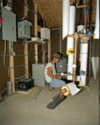H4. Replace Inefficient Heating Plant
Description
Replacing the old heating plant in a building can generate considerable savings if the existing equipment is inefficient and/or the fuel source is expensive compared to other options. A boiler or furnace near the end of its useful life is a particularly good candidate for replacement with high-efficiency equipment.
For this ECM, we discuss several options for replacing the heating plant. To evaluate the cost-effectiveness of other options, consult an experienced professional.
 Older furnaces and boilers may not operate as efficiently as they did when they were new, particularly if they have not been properly maintained over the years. In addition, because of technology advances, new boilers and furnaces are much more efficient than they use to be, presenting opportunities for saving on heating costs. Replacing the heating plant also provides an opportunity to switch to a less expensive fuel type. For example, where electricity is expensive relative to gas, it may be cost-effective to replace the heating system with a high-efficiency gas system. Heat pump technology has advanced over the past decade, making heat pumps an attractive option in some applications.
Older furnaces and boilers may not operate as efficiently as they did when they were new, particularly if they have not been properly maintained over the years. In addition, because of technology advances, new boilers and furnaces are much more efficient than they use to be, presenting opportunities for saving on heating costs. Replacing the heating plant also provides an opportunity to switch to a less expensive fuel type. For example, where electricity is expensive relative to gas, it may be cost-effective to replace the heating system with a high-efficiency gas system. Heat pump technology has advanced over the past decade, making heat pumps an attractive option in some applications.
Applicability
- Single-family and multifamily buildings
- Central boilers or furnaces with combustion efficiency of less than 60 percent, if the burner is forced-draft (power burner)
- Central boilers or furnaces with combustion efficiency of less than 75 percent, if the burner is natural draft (atmospheric burner)
- Electric heating systems in areas where electricity is expensive relative to other fuels
Types
- High-efficiency gas- or oil-fired boilers
- 85-percent AFUE oil boilers
- 85-percent AFUE gas boilers
- High-efficiency gas and oil furnaces
- 90-percent AFUE gas furnaces
- 90-percent AFUE oil furnaces
- Efficient electric heat pumps
- 12 SEER/7HSPF air source heat pumps
- 13 EER/2.8 COP geothermal heat pumps
Considerations
- Perform a life-cycle cost analysis prior to replacing major systems.
- Consult a qualified engineer when evaluating heating system replacement and installation.
- Boilers and furnaces should be properly sized for the building.
- High-efficiency boilers can be installed in a modular configuration of several smaller boilers instead of one large boiler.
- Other heating system ECMs should be evaluated as alternatives or complements to this ECM.
- Before installing a new heating system, cost-effective architectural measures should be installed.
Performance/Economics
- Efficient gas and oil boilers:
- Condensing boilers with AFUEs above 85 percent are the most efficient
- Efficient gas or oil furnaces:
- Condensing furnaces with AFUEs above 85 percent are the most efficient
- Multi- and variable-speed furnaces provide enhanced comfort and efficiency
- Efficient electric heat pumps:
- Heat pumps are 1.5 to 3 times more efficient than electric resistance heat
Resources/Links
Energy Conservation for Housing – A Workbook, HUD, September 1998. Pages 7-53 through 7-57 address replacing inefficient heating plants.
Energy Performance Contracting for Public and Indian Housing: A Guide for Participants, HUD, February 1992. Pages 23 through 26 address heating system opportunities under performance contracting.
ENERGY STAR Program: Heating and Cooling Equipment. Provides information on high-efficiency heating products, tips on finding a contractor, and guidance on sizing and installation.
Improving Energy Efficiency in Apartment Buildings, American Council for an Energy-Efficient Economy, 1995. ISBN 0-918249-23-6. Pages 68 through 88 address heating plants in apartment buildings.
Heating and Cooling Your Home. Discusses modifications to increase the energy efficiency of heating plants.
|
TURN OFF UTILITIES: Turn off electricity, gas, propane, and other utilities before starting repairs, cleaning, or installations to avoid accident or injury. BE AWARE OF LEAD-BASED PAINT HAZARDS: Many residences built before 1978 have paint that contains lead, which can pose a serious health hazard if paint, chips, and dust are not handled properly. See the U.S. Environmental Protection Agency (EPA) lead brief before disturbing painted surfaces in homes of this vintage. Follow the HUD "Lead-Safe Housing Rule" for requirements for notification, evaluation and reduction of lead-based paint hazards. BE AWARE OF ASBESTOS HAZARDS: Homes older than 1977 may have building products that contain asbestos such as insulation, high-temperature gaskets, roofing and siding shingles, and vinyl sheet flooring. See the EPA asbestos brief before disturbing such materials. BE AWARE OF MOLD AND MOISTURE HAZARDS: Molds can gradually destroy materials they grow on; can irritate the eyes, skin, nose, throat, and lungs of both mold-allergic and non-allergic people; can cause asthma attacks in people with asthma who are allergic to mold; and can cause other serious health problems. To learn more about preventing and cleaning up mold in homes, see these mold guides and the EPA brief on What to Wear When Cleaning Moldy Areas. |